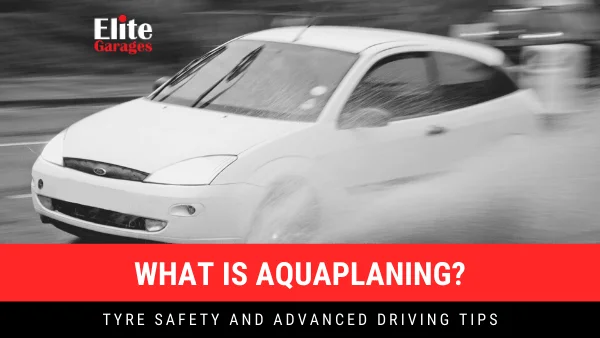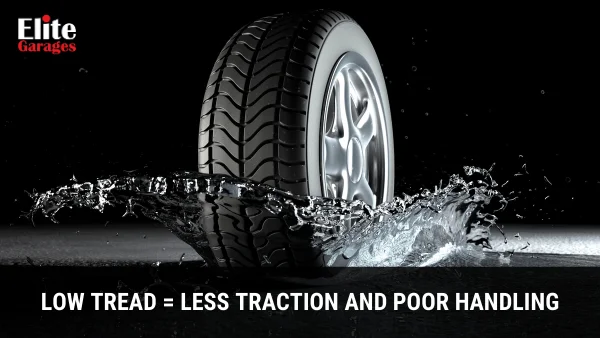
What Is Aquaplaning And How To Avoid It?
The Dangers Of Aquaplaning And Tyre Safety Tips
Aquaplaning is common in the UK, especially considering it rains for an average of 156.2 days. Whenever water is on the road surface, there’s a real risk of aquaplaning which means motorists need to know how to stay safe.
For aquaplaning to occur, water needs to be at least 2.5mm (or 1/10 of an inch) deep. It can also happen when the road surface is so uneven that it causes large puddles of standing water. You can’t always see how deep a puddle is so it’s best to reduce speed during (and after) heavy rainfall.
In this article, you’ll discover the causes of aquaplaning, including the role that worn tyres play, and how to safely handle your vehicle. Fasten your seatbelt as things are about to get serious!
What Is Aquaplaning And Why Is It So Dangerous?
Aquaplaning, also referred to as hydroplaning, occurs when a layer of water builds up between your tyres and the surface of the road. When this happens, your tyres struggle to grip the road properly which results in less traction.
A loss of traction means drivers can easily lose control of the vehicle making it incredibly difficult to steer, brake or accelerate. Hydroplaning can be a rather frightening experience where the result is often an accident. There are a few tell-tale signs that your car is aquaplaning which include the following:
- An increase in engine noise as it suddenly becomes louder
- It feels like you’ve dropped down gears while driving at speed as the revs tend to increase
- Your steering feels ‘lighter’
- The back end of your car starts drifting from side to side (‘fishtailing’)
The Main Factors Contributing To Hydroplaning
We’ve already touched on the road conditions, speed and tyres but we felt it was important to summarise some of the main contributing factors of aquaplaning.
- Speed remains the biggest contributor as the faster you go, the less time your tyres have to move the water away
- The tread design also plays a part as some patterns channel water better than others
- Bigger tyre size means a larger surface area which equates to less risk
- Worn tyres result in reduced grip and less chance of water being channelled away
- The wrong tyre pressure can increase your risk of aquaplaning
- Deeper surface water means it’s harder for your tyres to maintain grip
- Factors like oil, dirt and salt along with ambient temperature
- Vehicle weight also plays a part as the lighter the car, the higher your risk of hydroplaning
- Hydroplaning on smooth roads is far more common than on grooved surfaces
How To Handle Your Vehicle When Aquaplaning
Hydroplaning happens most often on slick, icy or snowy roads but it’s also likely in heavy rain. When you feel the back-end starting to skid, remember the following vital pointers:
- Don’t panic and try to remain calm
- If possible, keep the steering wheel straight and gently apply the brakes so you can slowly regain control
- If you feel the rear wheels are skidding, turn the steering wheel in the same direction. For example, if the back-end is sliding toward the driver’s side, turn the steering wheel to the right and vice versa
- Never slam on the brakes as it could make things worse. Instead, take your foot off the accelerator and gently pump the brakes if they’re standard. For anti-lock brakes (ABS), apply steady pressure instead of pumping
- If you have cruise control, switch it off
Can Worn Tyres Cause Aquaplaning?
When driving on tyres with less tread, your vehicle will struggle to clear as much water and could even worsen the situation. In the wrong conditions, the risks add up as worn tread allows a build-up of water beneath the tyres.
Good quality tyres can significantly reduce the risk of hydroplaning as they can clear the equivalent of a bucket of water from the road surface every seven seconds. That means tyres with a good amount of tread can safely handle a large amount of water when driving in the rain.
Having been in the servicing industry for more than 50 years, we pride ourselves on being your local tyre experts. We supply all kinds of tyres for every budget and vehicle with thousands in stock while offering same-day delivery and fitment. Reserve your tyres online today and ensure the safety of you and your family.
The Importance Of Tyre Safety

Considering tyres are the only parts that connect your vehicle to the road, making sure that they’re in excellent condition is vital. Today, even with countless driver safety tips and precautions, many drivers neglect their tyres and fail to understand their significant impact on general safety.
As we’ve already established with aquaplaning, more tyre tread means better grip which is essential in maintaining control, especially in challenging conditions. If you care for your tyres in terms of tread wear, wheel alignment and tyre pressure, you can increase their lifespan dramatically.
One of the most important checks is the tread depth as it affects grip and handling. New tyres will have a full 8mm of tread and while the minimum legal tread depth is 1.6mm, you really should change your tyres when they reach 3mm.
Recommended: ‘When Should I Replace My Tyres?’
Why Choose Elite Garages For Your Tyres?
Elite Garages is one of the leading fast-fit retailers in the country and, as a member of Group Tyre, we represent more than 15% of the total tyres sold in the UK. We have over 1 million tyres in stock across the entire group, offering you excellent availability and variety, from performance tyres, commercial tyres, eco-friendly and general-use tyres or touring tyres.
With Elite, you can reserve your tyres online and arrange for same-day fitting or the next day if we don’t have stock of your preferred tyre. Concerned about the condition of your car tyres? Bring it to your nearest branch for a FREE tyre safety check. We are here to help you with all your tyre needs, MOTs, car services, wheel alignment and much more.
About Us
Opening Times
Saturday : 8:30–4:00
Sunday : closed
More Information
Contact UsCustomer Information Pack
Check MOT Due Date
Free MOT reminder
Careers
Legal Information
Recent Posts
- Why Car Problems Happen More Often in January (And What Drivers Miss)
- Why the Right Car Service Garage Matters: Advice Drivers Trusted Most in 2025
- Christmas Guide to Winter Car Checks: From All of Us at Elite Garages
- Want to Prevent Exhaust Damage and Reduce Emissions?
- Regular Car Maintenance: Joe Achilles Tests Elite Garages’ 250,000-Mile BMW


